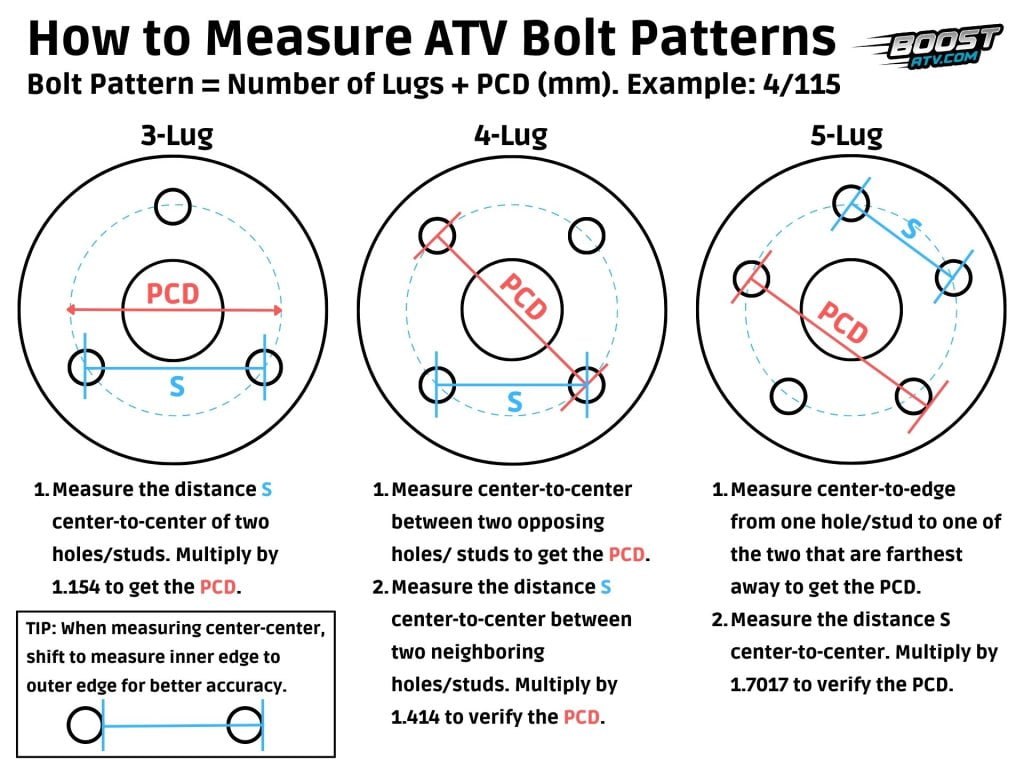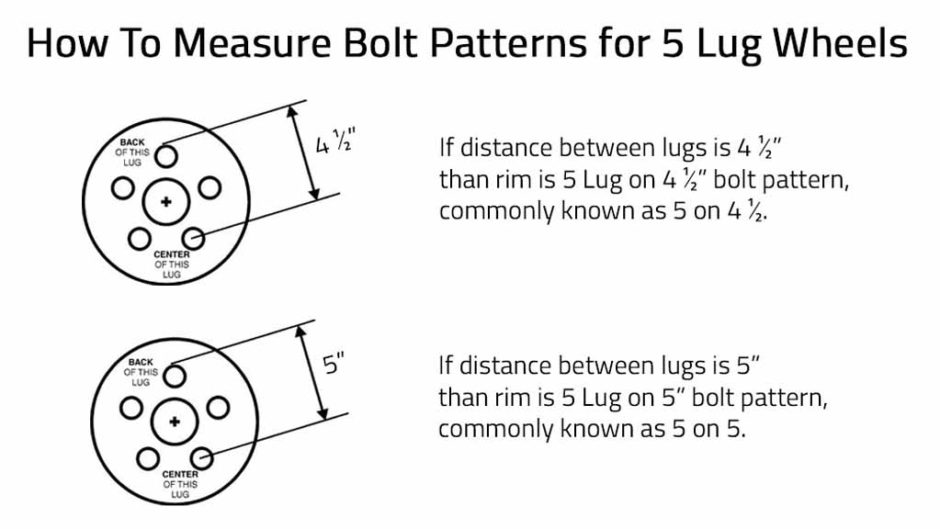Decoding Bolt Patterns: Your Guide to Perfect Wheel Fitment
Ever dreamt of upgrading your car's wheels, envisioning that perfect blend of style and performance? It's a common aspiration for car enthusiasts and everyday drivers alike. But before you dive into the world of alloy rims and custom designs, there's a crucial step you absolutely can't skip: determining your car's bolt pattern. This seemingly small detail can make or break your wheel upgrade, so understanding how to identify bolt patterns is essential for a successful and safe modification.
A bolt pattern, also known as a bolt circle or PCD (pitch circle diameter), refers to the arrangement of the lug holes on your car's hub. It's the blueprint that dictates which wheels will fit your vehicle. Accurately measuring this pattern is paramount, as an incorrect fit can lead to vibrations, wheel damage, and even potentially dangerous driving situations. This guide will walk you through the process, ensuring you have the knowledge to choose the perfect wheels for your ride.
The history of bolt patterns is intertwined with the evolution of the automobile itself. As cars became more sophisticated, so did their wheel designs. Standardization was necessary to ensure interchangeability and safety. Over time, various bolt patterns emerged, each tailored to specific vehicle types and manufacturers. Understanding this history provides context to the importance of correct bolt pattern identification today.
Why is measuring a bolt pattern so crucial? Simply put, it's the foundation of safe and effective wheel fitment. An incorrect bolt pattern can lead to a number of problems, including loose wheels, vibrations, and damage to the wheel studs or hubs. In extreme cases, a mismatched bolt pattern can cause the wheel to detach from the vehicle while driving, posing a severe safety hazard. Therefore, precise bolt pattern determination is non-negotiable.
Determining your car's bolt pattern involves identifying two key factors: the number of lug holes and the diameter of the circle that connects the centers of those holes (PCD). For example, a bolt pattern of 5x114.3 signifies five lug holes and a PCD of 114.3 millimeters. Various tools, including calipers and bolt pattern gauges, can help you obtain accurate measurements.
Benefit 1: Safety. A correct bolt pattern ensures your wheels are securely attached, preventing potential accidents.
Benefit 2: Performance. Proper wheel fitment minimizes vibrations, contributing to a smoother and more efficient ride.
Benefit 3: Aesthetics. Knowing your bolt pattern allows you to choose from a wider selection of wheels, achieving the desired look for your car.
Step-by-Step Guide to Measuring a Bolt Pattern: For wheels with an even number of lugs, measure from the center of one lug hole directly across to the center of the opposite lug hole. For wheels with an odd number of lugs, measure from the back edge of one lug hole to the center point of the lug hole directly across from it. Use a caliper for accurate measurements.
Advantages and Disadvantages of Accurate Bolt Pattern Measurement
| Advantages | Disadvantages |
|---|---|
| Safety | Requires some effort and tools |
| Performance | |
| Wider wheel selection |
Best Practice 1: Use a reliable caliper for accurate PCD measurement.
Best Practice 2: Double-check your measurements to ensure accuracy.
Best Practice 3: Consult your vehicle's owner's manual for the recommended bolt pattern.
Best Practice 4: Seek professional assistance if you are unsure about the process.
Best Practice 5: Always use the correct lug nuts for your new wheels.
Real Example 1: A car owner wanting to install aftermarket wheels correctly measured the bolt pattern to ensure compatibility.
Real Example 2: A mechanic identified a mismatched bolt pattern as the cause of a customer's wheel vibration.
Real Example 3: A car enthusiast researched various bolt patterns to find the perfect wheel fitment for their project car.
Real Example 4: A tire shop used a bolt pattern gauge to quickly and accurately determine a customer's bolt pattern.
Real Example 5: An online forum discussion helped a car owner understand the importance of measuring their bolt pattern before purchasing new wheels.
FAQ 1: What is a bolt pattern? A: It's the arrangement of lug holes on a wheel hub.
FAQ 2: How do I measure a bolt pattern? A: Use a caliper or bolt pattern gauge.
FAQ 3: Why is it important to measure a bolt pattern? A: For safety, performance, and proper wheel fitment.
FAQ 4: What happens if I use the wrong bolt pattern? A: Vibrations, damage, and potential wheel detachment.
FAQ 5: Where can I find my car's bolt pattern? A: Owner's manual, online resources, or a professional.
FAQ 6: Can I change my car's bolt pattern? A: Generally, no, it's a complex modification.
FAQ 7: Are there different types of bolt patterns? A: Yes, various patterns exist based on the number of lugs and PCD.
FAQ 8: What tools do I need to measure a bolt pattern? A: A caliper or bolt pattern gauge is recommended.
Tips and Tricks: Use a digital caliper for more precise measurements. Clean the wheel hub surface before measuring. Consult online resources for bolt pattern charts and guides.
In conclusion, measuring a bolt pattern is a fundamental step in ensuring proper wheel fitment, enhancing both safety and performance. By understanding the process and utilizing the right tools, you can confidently choose wheels that perfectly match your vehicle. From preventing potentially dangerous situations to optimizing your driving experience, accurate bolt pattern identification is crucial. Remember to double-check your measurements, consult reliable resources, and seek professional advice when needed. Don't underestimate the significance of this seemingly small detail. Take the time to measure correctly, and enjoy the benefits of a perfectly fitted set of wheels, knowing you've prioritized safety and performance. This knowledge empowers you to make informed decisions, enhancing your overall driving experience and ensuring your car performs at its best. Now go ahead and confidently embark on your wheel upgrade journey, armed with the knowledge to make the right choice!
Unlocking hydraulic systems a comprehensive guide to hydraulic symbols and their meanings
So you think you can fly cracking the flight attendant interview attire code
Online booking of passport your gateway to seamless travel













